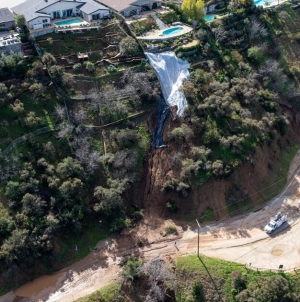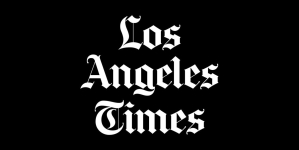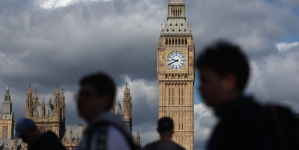-
In Occupied Ukraine, Casting a Vote (for Putin) as Armed Soldiers Watch - March 16, 2024
-
A portion of Mulholland Drive, damaged by mudslides in winter storms, reopens - May 26, 2024
-
‘Maybe You Don’t Want to Win’ - May 26, 2024
-
Donald Trump Putting Law Enforcement in Danger: Attorney - May 26, 2024
-
Avoid the waters of these 5 L.A. County beaches this holiday weekend, public health officials say - May 26, 2024
-
Bawdy Comedy ‘Anora’ Wins Palme d’Or at Cannes Film Festival - May 26, 2024
-
Map Shows Heat Wave Zone Spread Into Five New States - May 26, 2024
-
Azusa police arrest suspected slingshot-wielding vandal - May 25, 2024
-
Donald Trump Hammers Judge Ahead of Jury Instructions - May 25, 2024
-
Sometimes U.S. and U.K. Politics Seem in Lock Step. Not This Year. - May 25, 2024
In Occupied Ukraine, Casting a Vote (for Putin) as Armed Soldiers Watch
A new sign went up a few miles from the front line recently on the main billboard of an occupied town in Ukraine’s Luhansk region.
“Vote for our president. Together we’re strong,” read the sign in the white, blue and red colors of the Russian flag, according to Anastasiia, a resident.
The message was clear to her: that the president was Vladimir V. Putin of Russia, not Volodymyr Zelensky of Ukraine, and that Mr. Putin was the only choice in the Russian presidential vote taking place in the occupied parts of Ukraine over the past three weeks.
Mr. Putin long ago transformed Russian elections into a predictable ritual meant to convey legitimacy to his rule. In the occupied territories, this practice has the additional goals of presenting the occupation as a fait accompli and identifying dissenters, said political analysts and Ukrainian officials.
“Elections in these regions fix the idea that they have the same laws and procedures as the rest of the country,” said Ilya Grashchenkov, a Russian political scientist who is advising a long-shot candidate running against Mr. Putin. That has the effect, he said, of weaving them into the fabric of Russian statehood.
For many in the occupied territories, the electoral ritual is unfolding under the watchful eyes of armed soldiers.
Wearing face coverings, the soldiers have accompanied poll workers door-to-door throughout the occupied parts of the four Ukrainian regions that Russia has annexed after invading the country two years ago, according to local residents, statements by Russian officials and videos posted on social media.
Occupation officials say the show of force is necessary to protect those collecting votes.
The poll workers are soliciting votes that are set to give Mr. Putin, who has no serious challenger on the ballot, his fifth term as president and another six years in office.
Ukrainian officials, Western allies and rights groups have called the elections an illegal sham. They say the vote is marred by widespread intimidation and coercion and is part of a wider campaign of repression against the residents of the occupied regions.
“They promote it, even though it’s not a real election,” said Anastasiia, the Luhansk region resident. “Everybody knows who will win.”
Anastasiia, 19, left the occupied territories this month to build her life away from the war zone. Citing fear of retribution, she asked to be identified by her first name only and to omit the name of her town to protect relatives who remained behind.
Few countries, if any, are expected to recognize the election results in the occupied regions, which include the Crimea peninsula, annexed in 2014 after Russia’s earlier aggression in southeastern Ukraine. The United Nations considers all of the territory to be part of Ukraine.
Analysts say the coercion, the numerous electoral machinations and the exodus of pro-Ukrainian residents mean that Mr. Putin is almost certain to obtain an even larger landslide in the occupied regions than in the rest of Russia.
For the Kremlin, it is the electoral process itself, rather than the margin of victory, that furthers its cause.
Conducting elections, no matter how orchestrated and unfair, in the occupied regions allows Mr. Putin to solidify his claim to them. It also allows him to portray himself as a champion of democracy and draw contrast with Ukraine, which suspended its presidential voting this year because of the war, said Mr. Grashchenkov, the political analyst.
Russia has already conducted two previous elections in the four regions of eastern and southern Ukraine that it has partly occupied since invading the country. The Kremlin claimed that 99 percent of the residents of Donetsk, the most populous of the occupied regions, chose to join Russia in 2022. Mr. Putin’s party candidates won a landslide victory in local voting held across the occupied territories last year.
Ukraine and Western nations have called those elections shams.
Apart from such votes, Russia has stamped out Ukrainian identity and language with Russian curriculums in schools, required Russian passports for employment and cracked down on people with pro-Ukrainian political views.
Russia’s attempts to replicate a normal election process often clash with the realities of war, sometimes in farcical ways.
For starters, Russia does not completely control the regions where it is purporting to conduct voting. And just months after it held a sham referendum as a way of proclaiming that the city of Kherson was part of Russia, its forces had to abandon the city to the Ukrainian army. (Russia remains in control of the southern portion of Kherson province).
A similar dissonance emerged as this month’s rubber-stamp presidential balloting approached.
Little is known, for example, about how many voters there are. The constant shifting of the front lines, the flight of the local residents and the arrival of hundreds of thousands of Russian soldiers and workers have dramatically transformed the demographics of the occupied regions. The full effect of this transformation remains largely unknown, because of strict Russian censorship and the ongoing fighting.
But the few available estimates point to a drastic decrease in the occupied population. Figures from Russia’s electoral commission show that the occupied part of the Kherson region, for example, lost 13 percent of its registered voters, or 75,000 adults, in the last three months of last year.
Overall, Russia’s electoral body claims the four Ukrainian regions that were annexed in 2022 have 4.5 million voters. This would represent a 33 percent drop from the last voter roll published by the Ukrainian government before the full-scale invasion. Ukrainian officials say the real number today is likely to be even lower.
The picture is complicated further by the Russian government’s decision to allow hundreds of thousands of soldiers stationed in the occupied territories to vote there. Russian propaganda videos published on social media have shown electoral workers dodging shells and diving into ditches to deliver ballot boxes to stoic soldiers in the trenches.
Russian authorities have not published the locations of the polling stations or the names of the members of the local electoral commissions. It has also leveraged the system to the state’s advantage.
Occupation officials have designated the occupied territories as “remote,” a label previously reserved for places like the reindeer herder communities in the Arctic. This has allowed Russia to extend the voting period there for three weeks, making the process even harder to monitor. Polls in two of the occupied regions, Zaporizhzhia and Donetsk, opened on Feb. 25 and will close on March. 17, when voting ends in Russia.
The “remote” designation has also allowed pro-Russian electoral officials to go door-to-door soliciting votes from residents of the occupied regions. And because voting there is taking place under martial law, these officials are accompanied by armed soldiers.
“Dear voters, we care about your safety!” the electoral commission for the occupied Zaporizhzhia wrote in a Telegram post this month, which showed camouflaged voters with blurred faces casting ballots. “You don’t need to go anywhere to vote — we will come with the ballots and the ballot boxes to your home.”
Russia’s electoral commission claimed that nearly 1.4 million votes had been cast in remote regions by March 11. In the last Russian presidential election, held in 2018, remote regions in Russia’s far north and east accounted for just 180,000 votes.
Ukrainian officials say this turnout is achieved by intimidation.
“‘Voting’ is conducted at gunpoint,” Dmytro Lubinets, the human rights ombudsman in Ukraine’s Parliament, said in a statement this month. “Participation in such ‘elections’ is a matter of survival.”
The actual wishes of the majority of the residents are impossible to decipher. No independent opinion polls have been published in the occupied territories since the invasion. And the exodus of pro-Ukrainian residents mean that many of those who remain often support, or have at least resigned themselves, to the occupation.
Russian officials have justified extraordinary voting procedures in the occupied territories as a security necessity. Ukrainian forces and partisans have frequently targeted Russian collaborators and occupation officials, including electoral workers.
Most recently, a deputy mayor of Berdiansk, on the Azov Sea coast, died in a car explosion on March 6. Ukraine’s military intelligence took responsibility, saying the official, Svetlana Samoilenko, was assassinated for forcing residents to “participate in illegal, fake voting.”
Ukrainian officials say Russia is also using elections to identify residents who are unhappy with its rule. The government in Kyiv says Ukrainians are routinely jailed, tortured or summarily executed by invading forces under a campaign of forced “Russification” of the occupied territories.
“If you vote, you are loyal to Russia, you have opportunities,” said Volodymyr Fesenko, a Kyiv-based political analyst. “If not, well, then you will be under pressure. You will be investigated.”
Alina Lobzina contributed reporting from London.































